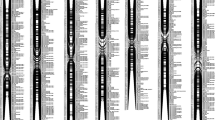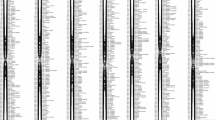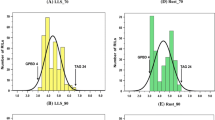Abstract
In a previous study a genetic map had been developed using a RIL population derived from a cross between the Pisum sativum ssp. syriacum accession P665 and the P. sativum ssp. sativum cv. Messire. This population segregated for several agricultural important traits and was successfully used to identify QTLs (Quantitative Trait Loci) controlling resistance to Mycosphaerella pinodes and Orobanche crenata, earliness, root length and aerial biomass. However, this map contained only a few markers in common with the international pea consensus map, hampering comparison with other pea maps. The objective of this study was to incorporate a set of common transferable and reproducible markers into the P665 × Messire map to favour comparative mapping and QTL validation. Seventy-eight out of the 248 SSRs assayed resulted polymorphic in the parental lines. Thirty-eight of them, uniformly distributed all over the genome, were genotyped in the whole population and included in the map. This SSR enriched map allowed identification of six new QTLs (three for resistance to M. pinodes, two for resistance to broomrape and one for root length). Inclusion of the SSRs confirmed the homology of some of the QTLs identified in the population P665 × Messire with other QTLs associated with related traits in different pea genetic backgrounds.

Similar content being viewed by others
References
Blixt S (1974) The pea. In: King RC (ed) Handbook of genetics. Plenium Press, New York, pp 181–221
Burstin J, Marget P, Huart M, Moessner A, Mangin B, Duchene C, Desprez B, Munier-Jolain N, Duc D (2007) Developmental genes have pleiotropic effects on plant morphology and source capacity, eventually impacting on seed protein content and productivity in pea. Plant Physiol 44:468–781
Churchill GA, Doerge RW (1994) Empirical threshold values for quantitative trait mapping. Genetics 198:963–971
Clulow SA, Lewis BG, Matthews P (1991) A pathotype classification for Mycosphaerella pinodes. Phytopathology 131:322–332
FAO (2010): http://faostat.fao.org/. Accessed 15 Jan 2010
Fondevilla S, Ávila CM, Cubero JI, Rubiales D (2005) Response to Mycosphaerella pinodes in a germplasm collection of Pisum spp. Plant Breeding 124:313–315
Fondevilla S, Satovic Z, Rubiales D, Moreno MT, Torres AM (2008) Mapping of quantitative trait loci for resistance to Mycosphaerella pinodes in Pisum sativum subsp syriacum. Mol Breed 21:439–454
Fondevilla S, Fernández-Aparicio M, Satovic Z, Emeran AA, Torres AM, Moreno MT, Rubiales D (2010) Identification of quantitative trait loci for specific mechanisms of resistance to Orobanche crenata Forsk. in pea (Pisum sativum L.). Mol Breed 25:259–272
Köpje U, Nemecek T (2010) Ecological services of faba bean. Field Crops Res 115:217–233
Kosambi DD (1994) The estimation of map distance from recombination values. Ann Eugen 12:172–175
Lander ES, Botstein D (1989) Mapping Mendelian factors underlying quantitative trait using RFLP linkage maps. Genetics 121:185–199
Lander ES, Green P, Abramson J, Barlow A, Dali MJ, Lincoln DE, Newburg L (1987) MAPMAKER: an interactive computer program for constructing genetic linkage maps of experimental and natural populations. Genomics 1:174–181
Lawyer SA (1984) Diseases caused by Ascochyta spp. In: Hargedon DJ (ed) Compendium of pea diseases. APS Press, St Paul, pp 11–15
Loridon K, McPhee K, Morin J, Dubreuil P, Pilet-Nayel ML, Aubert G, Rameau C, Baranger A, Coyne C, Lejeune-Henaut I, Burstin J (2005) Microsatellite marker polymorphism and mapping in pea (Pisum sativum L.). Theor Appl Genet 111:1022–1031
Prioul S, Frankewitz A, Deniot G, Morin G, Baranger A (2004) Mapping of quantitative trait loci for partial resistance to Mycosphaerella pinodes in pea (Pisum sativum L.) at the seedling and adult plant stages. Theor Appl Genet 108:1322–1334
Roger C, Tivoli R (1996) Spatio temporal development of pynidia and perithecia and dissemination of spores of Mycosphaerella pinodes on pea (Pisum sativum). Plant Pathol 45:518–528
Rubiales D, Fondevilla S (2010) Resistance of cool season food legumes to Ascochyta blight. Field Veg Crop Res 47:439–442
Rubiales D, Pérez-de-Luque A, Cubero JI, Sillero JC (2003a) Crenate broomrape (Orobanche crenata) infection in field pea cultivars. Crop Prot 22:865–872
Rubiales D, Pérez-de-Luque A, Joel DM, Alcántara C, Sillero JC (2003b) Characterization of resistance in chickpea to crenata broomrape (Orobanche crenata). Weed Sci 51:702–707
Rubiales D, Moreno MT, Sillero JC (2005) Search for resistance to crenate broomrape (Orobanche crenata) in pea germplasm. Genet Resour Crop Evol 52:853–861
Rubiales D, Fernández-Aparicio M, Mora A, Barilli E, Sillero JC, Fondevilla S (2009a) Disease resistance in pea (Pisum sativum L.) types for autumn sowings in Mediterranean environments. Czech J Genet Plant Breed 45:135–142
Rubiales D, Fernández-Aparicio M, Pérez-de-Luque A, Prats E, Castillejo MA, Sillero J, Rispail N, Fondevilla S (2009b) Breeding approaches for crenate broomrape (Orobanche crenata Forsk.) management in pea (Pisum sativum L.). Pest Manag Sci 65:553–559
Wallen VR (1965) Field evaluation of the importance of the Ascochyta complex of peas. Can J Plant Sci 45:27–33
Wang S, Basten CJ, Gaffney P, Zeng Z-B (2005) Windows QTL cartographer version 2.5. Statistical genetics. North Carolina State University, Raleigh
Wroth JM (1998) Possible role for wild genotypes of Pisum spp. to enhance ascochyta bligt resistance in pea. Aust J Exp Agr 38:469–479
Xue AG, Warkentin TD, Kenaschuk EO (1997) Effect of timings of inoculation with Mycosphaerella pinodes on yield and seed infection on field pea. Can J Plant Sci 77:685–689
Zeng ZB (1994) Precision mapping of quantitative trait loci. Genetics 136:1457–1468
Zhang Y, Stommel JR (2001) Development of SCAR and CAPS markers linked to the Beta gene in tomato. Crop Sci 41:1602–1608
Acknowledgments
Support by projects AGL2008-01239 and RTA2007-00030 is acknowledged. SF was funded by Juan de la Cierva Program of the Spanish MICINN.
Author information
Authors and Affiliations
Corresponding author
Rights and permissions
About this article
Cite this article
Fondevilla, S., Almeida, N.F., Satovic, Z. et al. Identification of common genomic regions controlling resistance to Mycosphaerella pinodes, earliness and architectural traits in different pea genetic backgrounds. Euphytica 182, 43–52 (2011). https://doi.org/10.1007/s10681-011-0460-8
Received:
Accepted:
Published:
Issue Date:
DOI: https://doi.org/10.1007/s10681-011-0460-8




